Title search results
Showing 341 - 360 of 1500443 items
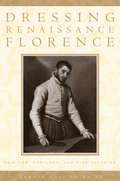
As portraits, private diaries, and estate inventories make clear, elite families of the Italian Renaissance were obsessed with fashion, investing…
as much as forty percent of their fortunes on clothing. In fact, the most elaborate outfits of the period could cost more than a good-sized farm out in the Mugello. Yet despite its prominence in both daily life and the economy, clothing has been largely overlooked in the rich historiography of Renaissance Italy. In Dressing Renaissance Florence, however, Carole Collier Frick provides the first in-depth study of the Renaissance fashion industry, focusing on Florence, a city founded on cloth, a city of wool manufacturers, finishers, and merchants, of silk dyers, brocade weavers, pearl dealers, and goldsmiths. From the artisans who designed and assembled the outfits to the families who amassed fabulous wardrobes, Frick's wide-ranging and innovative interdisciplinary history explores the social and political implications of clothing in Renaissance Italy's most style-conscious city.Frick begins with a detailed account of the industry itself—its organization within the guild structure of the city, the specialized work done by male and female workers of differing social status, the materials used and their sources, and the garments and accessories produced. She then shows how the driving force behind the growth of the industry was the elite families of Florence, who, in order to maintain their social standing and family honor, made continuous purchases of clothing—whether for everyday use or special occasions—for their families and households. And she concludes with an analysis of the clothes themselves: what pieces made up an outfit; how outfits differed for men, women, and children; and what colors, fabrics, and design elements were popular. Further, and perhaps more basically, she asks how we know what we know about Renaissance fashion and looks to both Florence's sumptuary laws, which defined what could be worn on the streets, and the depiction of contemporary clothing in Florentine art for the answer.For Florence's elite, appearance and display were intimately bound up with self-identity. Dressing Renaissance Florence enables us to better understand the social and cultural milieu of Renaissance Italy.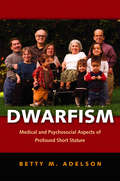
Dwarfism: Medical and Psychosocial Aspects of Profound Short Stature
By Betty M. Adelson. 2005
This landmark volume is the first to trace the exciting developments in the field of dwarfism research and treatment over…
the past century—particularly during the past fifty years. Dr. Betty M. Adelson, a psychologist, has unearthed and synthesized the most significant information about dwarfing conditions, from articles written a century ago to current books and specialized databases. Highlighting the outstanding contributions of Dr. Victor McKusick and several of his colleagues, Dr. Adelson reveals how dwarfism specialists have helped redefine the nature of medical care—transforming it from an authoritarian enterprise into a holistic, collaborative venture among physicians, affected individuals, and their families. The parent of an adult dwarf daughter, Adelson examines the social forces that affect the dwarfism community. She offers personal descriptions of the day-to-day challenges dwarf individuals face and portrays their accomplishments. Insightful and accessible, this work will prove a valuable resource for affected individuals, their families, and medical professionals—physicians, nurses, genetic counselors, social workers, psychologists, and medical students.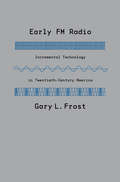
Early FM Radio: Incremental Technology in Twentieth-Century America
By Gary L. Frost. 2010
The commonly accepted history of FM radio is one of the twentieth century’s iconic sagas of invention, heroism, and tragedy.…
Edwin Howard Armstrong created a system of wideband frequency-modulation radio in 1933. The Radio Corporation of America (RCA), convinced that Armstrong’s system threatened its AM empire, failed to develop the new technology and refused to pay Armstrong royalties. Armstrong sued the company at great personal cost. He died despondent, exhausted, and broke. But this account, according to Gary L. Frost, ignores the contributions of scores of other individuals who were involved in the decades-long struggle to realize the potential of FM radio. The first scholar to fully examine recently uncovered evidence from the Armstrong v. RCA lawsuit, Frost offers a thorough revision of the FM story. Frost’s balanced, contextualized approach provides a much-needed corrective to previous accounts. Navigating deftly through the details of a complicated story, he examines the motivations and interactions of the three communities most intimately involved in the development of the technology—Progressive-era amateur radio operators, RCA and Westinghouse engineers, and early FM broadcasters. In the process, Frost demonstrates the tension between competition and collaboration that goes hand in hand with the emergence and refinement of new technologies. Frost's study reconsiders both the social construction of FM radio and the process of technological evolution. Historians of technology, communication, and media will welcome this important reexamination of the canonic story of early FM radio.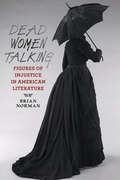
Dead Women Talking: Figures of Injustice in American Literature
By Brian Norman. 2013
Dead women speak as agents of social justice in work by some of the best-known writers of American literature.Brian Norman…
uncovers a curious phenomenon in American literature: dead women who nonetheless talk. These characters appear in works by such classic American writers as Poe, Dickinson, and Faulkner as well as in more recent works by Alice Walker, Toni Morrison, Tony Kushner, and others. These figures are also emerging in contemporary culture, from the film and best-selling novel The Lovely Bones to the hit television drama Desperate Housewives. Dead Women Talking demonstrates that the dead, especially women, have been speaking out in American literature since well before it was fashionable. Norman argues that they voice concerns that a community may wish to consign to the past, raising questions about gender, violence, sexuality, class, racial injustice, and national identity. When these women insert themselves into the story, they do not enter precisely as ghosts but rather as something potentially more disrupting: posthumous citizens. The community must ask itself whether it can or should recognize such a character as one of its own. The prospect of posthumous citizenship bears important implications for debates over the legal rights of the dead, social histories of burial customs and famous cadavers, and the political theory of citizenship and social death.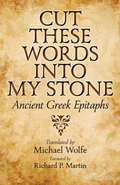
Cut These Words into My Stone: Ancient Greek Epitaphs
By Michael Wolfe. 2013
The lively ancient epitaphs in this bilingual collection fit together like small mosaic tiles, forming a vivid portrait of Greek…
society.Cut These Words into My Stone offers evidence that ancient Greek life was not only celebrated in great heroic epics, but was also commemorated in hundreds of artfully composed verse epitaphs. They have been preserved in anthologies and gleaned from weathered headstones.Three-year-old Archianax, playing near a well,Was drawn down by his own silent reflection.His mother, afraid he had no breath left,Hauled him back up wringing wet. He had a little.He didn't taint the nymphs' deep home.He dozed off in her lap. He's sleeping still.These words, translated from the original Greek by poet and filmmaker Michael Wolfe, mark the passing of a child who died roughly 2,000 years ago. Ancient Greek epitaphs honor the lives, and often describe the deaths, of a rich cross section of Greek society, including people of all ages and classes— paupers, fishermen, tyrants, virgins, drunks, foot soldiers, generals—and some non-people—horses, dolphins, and insects. With brief commentary and notes, this bilingual collection of 127 short, witty, and often tender epigrams spans 1,000 years of the written word. Cut These Words into My Stone provides an engaging introduction to this corner of classical literature that continues to speak eloquently in our time.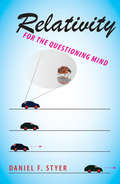
Relativity for the Questioning Mind
By Daniel F. Styer. 2011
To those of us who are not mathematicians or physicists, Einstein’s theory of relativity often seems incomprehensible, exotic, and of…
little real-world use. None of this is true. Daniel F. Styer’s introduction to the topic not only shows us why these beliefs are mistaken but also shines a bright light on the subject so that any curious-minded person with an understanding of algebra and geometry can both grasp and apply the theory.Styer starts off slowly and proceeds carefully, explaining the concepts undergirding relativity in language comprehensible to nonscientists yet precise and accurate enough to satisfy the most demanding professional. He demonstrates how the theory applies to various real-life situations with easy equations and simple, clear diagrams. Styer's classroom-tested method of conveying the core ideas of relativity—the relationship among and between time, space, and motion and the behavior of light—encourages questions and shows the way to finding the answers. Each of the book’s four parts builds on the sections that come before, leading the reader by turn through an overview of foundational ideas such as frames of reference, revelatory examples of time dilation and its attendant principles, an example-based exploration of relativity, and explanations of how and why gravity and spacetime are linked. By demonstrating relativity with practical applications, Styer teaches us to truly understand and appreciate its importance, beauty, and usefulness.Featuring worked and end-of-chapter problems and illustrated, nontechnical explanations of core concepts, while dotted throughout with questions and answers, puzzles, and paradoxes, Relativity for the Questioning Mind is an enjoyable-to-read, complete, concise introduction to one of the most important scientific theories yet discovered. The appendixes provide helpful hints, basic answers to the sample problems, and materials to stimulate further exploration.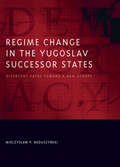
Regime Change in the Yugoslav Successor States: Divergent Paths toward a New Europe (Democratic Transition and Consolidation)
By Mieczysław P. Boduszyński. 2010
In the 1990s, amid political upheaval and civil war, the Socialist Federal Republic of Yugoslavia dissolved into five successor states.…
The subsequent independence of Montenegro and Kosovo brought the total number to seven. Balkan scholar and diplomat to the region Mieczyslaw P. Boduszynski examines four of those states—Croatia, Slovenia, Macedonia, and the Federal Republic of Yugoslavia—and traces their divergent paths toward democracy and Euro-Atlantic integration over the past two decades.Boduszynski argues that regime change in the Yugoslav successor states was powerfully shaped by both internal and external forces: the economic conditions on the eve of independence and transition and the incentives offered by the European Union and other Western actors to encourage economic and political liberalization. He shows how these factors contributed to differing formulations of democracy in each state.The author engages with the vexing problems of creating and sustaining democracy when circumstances are not entirely supportive of the effort. He employs innovative concepts to measure the quality of and prospects for democracy in the Balkan region, arguing that procedural indicators of democratization do not adequately describe the stability of liberalism in post-communist states. This unique perspective on developments in the region provides relevant lessons for regime change in the larger post-communist world. Scholars, practitioners, and policymakers will find the book to be a compelling contribution to the study of comparative politics, democratization, and European integration.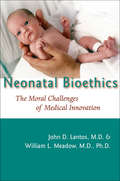
Neonatal Bioethics: The Moral Challenges of Medical Innovation (Bioethics)
By John D. Lantos, William L. Meadow. 2007
Neonatal intensive care has been one of the most morally controversial areas of medicine during the past thirty years. This…
study examines the interconnected development of four key aspects of neonatal intensive care: medical advances, ethical analysis, legal scrutiny, and econometric evaluation.The authors assert that a dramatic shift in societal attitudes toward newborns and their medical care was a stimulus for and then a result of developments in the medical care of newborns. They divide their analysis into three eras of neonatal intensive care. The first, characterized by the rapid advance of medical technology from the late 1960s to the Baby Doe case of 1982, established neonatal care as a legitimate specialty of medical care, separate from the rest of pediatrics and medicine. During this era, legal scholars and moral philosophers debated the relative importance of parental autonomy, clinical prognosis, and children's rights. The second era, beginning with the Baby Doe case (a legal battle that spurred legislation mandating that infants with debilitating birth defects be treated unless the attending physician deems efforts to prolong life "futile"), stimulated efforts to establish a consistent federal standard on neonatal care decisions and raised important moral questions concerning the meaning of "futility" and of "inhumane" treatment. In the third era, a consistent set of decision-making criteria and policies was established. These policies were the result of the synergy and harmonization of newly agreed upon ethical principles and newly discovered epidemiological characteristics of neonatal care.Tracing the field's recent history, notable advances, and considerable challenges yet to be faced, the authors present neonatal bioethics as a paradigm of complex conversation among physicians, philosophers, policy makers, judges, and legislators which has led to responsible societal oversight of a controversial medical innovation.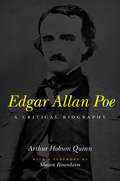
Edgar Allan Poe: A Critical Biography
By Arthur Hobson Quinn. 1998
Now in paperback—the classic, monumental biography of Poe by Arthur Hobson Quinn.Renowned as the creator of the detective story and…
a master of horror, the author of "The Red Mask of Death," "The Black Cat," and "The Murders of the Rue Morgue," Edgar Allan Poe seems to have derived his success from suffering and to have suffered from his success. "The Raven" and "The Tell-Tale Heart" have been read as signs of his personal obsessions, and "The Fall of the House of Usher" and "The Descent into the Maelstrom" as symptoms of his own mental collapse. Biographers have seldom resisted the opportunities to confuse the pathologies in the stories with the events in Poe's life. Against this tide of fancy, guesses, and amateur psychologizing, Arthur Hobson Quinn's biography devotes itself meticulously to facts. Based on exhaustive research in the Poe family archive, Quinn extracts the life from the legend, and describes how they both were distorted by prior biographies.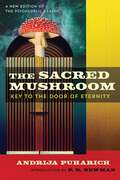
The Sacred Mushroom: Key to the Door of Eternity
By Andrija Puharich. 2025
• Shares the author&’s research on extrasensory perception (ESP) and the psychic effects of hallucinogenic mushrooms• Describes ancient Egyptian spiritual…
practices centered on Amanita muscaria (fly agaric) mushrooms• Details the author&’s research work with R. Gordon Wasson and his experiments with Aldous Huxley and famed psychic Peter HurkosIn 1954, neurologist Andrija Puharich, M.D., receives a call from a wealthy supporter of his lab about an unusual subject worthy of further research: Harry Stone, a young sculptor with unusually acute extrasensory perception. When handed an ancient Egyptian artifact, Harry had fallen into a deep trance, drawing hieroglyphic symbols, including mushrooms, and using ancient Egyptian phrases to describe a drug that can enhance psychic abilities.Intrigued, Dr. Puharich studies Harry&’s trance-induced statements and discovers that they are clearly describing ancient spiritual practices involving Amanita muscaria (fly agaric) mushrooms. He begins direct investigations with Harry at his lab in Maine, learning more about the use and preparation of the sacred mushroom as well as about astral travel and past lives. Dr. Puharich shares his research with ethnomycologist R. Gordon Wasson, who is about to travel to Mexico on a CIA-funded research trip, and the two researchers agree to test telepathic communications between the lab in Maine and a Mexican curandero. The results of the psychic experiment lead Puharich to discover Amanita muscaria growing in the wild near his research facility.Now with a supply of the sacred mushroom, Dr. Puharich begins to study its psychic and visionary potential and the veracity of Harry Stone&’s channeled Egyptian statements. He studies the effects of Amanita muscaria not only on Harry, but also on famed psychic Peter Hurkos and other visitors to his lab, including Aldous Huxley. This book reveals all the details of that story in this new edition of the psychedelic classic. It also includes an in-depth introduction by psychedelic historian P. D. Newman.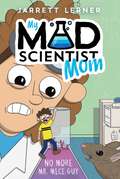
No More Mr. Mice Guy (My Mad Scientist Mom)
By Jarrett Lerner. 2025
Ari helps a neighbor who accidentally gets shrunk by Ari&’s mom&’s latest invention in this second book in the My…
Mad Scientist Mom chapter book series from acclaimed author-illustrator Jarrett Lerner.Ari&’s life is filled with school, video games, and his pet turtle, Fred: pretty run-of-the mill stuff. But not anywhere near run-of-the-mill is Ari&’s mom, who&’s a mad scientist. That&’s right, a MAD scientist. Sure, she strives to make people&’s lives better with her inventions, especially at home. But all of Mom&’s inventions seem to go just the slightest bit off kilter. His mom puts a new invention to the test to help clean up the clutter in their house: a magnimizer, which can shrink or enlarge anything! Pretty amazing, right? Well, not if you happen to be Mr. Jakes, their neighbor who comes face to face with this gizmo and becomes the size of a cockroach—and a potential tasty morsel for the resident basement mouse! Can Ari save the day and teeny-weeny Mr. Jakes?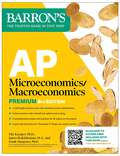
AP Microeconomics/Macroeconomics Premium, Eighth Edition: Prep Book with 4 Practice Tests + Comprehensive Review + Online Practice (Barron's AP Prep)
By Frank Musgrave, Elia Kacapyr, James Redelsheimer M.A., Barron'S Educational Series. 2024
Be prepared for exam day with Barron&’s. Trusted content from AP experts! Barron&’s AP Microeconomics/Macroeconomics Premium, Eighth Edition includes in‑depth…
content review and practice. It&’s the only book you&’ll need to be prepared for exam day. Written by Experienced Educators Learn from Barron&’s‑‑all content is written and reviewed by AP experts Build your understanding with comprehensive review tailored to the most recent exams Get a leg up with tips, strategies, and study advice for exam day‑‑it&’s like having a trusted tutor by your side Be Confident on Exam Day Sharpen your test‑taking skills with 4 full‑length practice tests–1 AP Micro exam and 1 AP Macro exam in the book, and 1 additional AP Micro exam and 1 additional AP Macro exam online–plus detailed answer explanations for all questions Strengthen your knowledge with in‑depth review covering all units on the AP Microeconomics exam and the AP Macroeconomics exam Determine your strengths and areas for improvement by taking pretests (that cover frequently tested topics) for both subjects Reinforce your learning with multiple-choice and free-response review questions at the end of each chapter, all accompanied by clear answers and explanations and graphs where needed to better illustrate key concepts Robust Online Practice Continue your practice with 1 full-length AP Micro practice test and 1 full-length AP Macro practice test on Barron&’s Online Learning Hub Simulate the exam experience with a timed test option Deepen your understanding with detailed answer explanations and expert advice Gain confidence with scoring to check your learning progress Strengthen your vocabulary with additional terms and their definitions by chapter for both Microeconomics and Macroeconomics. Publisher's Note: Products purchased from 3rd party sellers are not guaranteed by the publisher for quality, authenticity, or access to any online entities included with the product.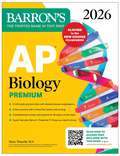
AP Biology Premium, 2026: Prep Book with 6 Practice Tests + Comprehensive Review + Online Practice (Barron's AP Prep)
By Mary Wuerth, Barron'S Educational Series. 2025
Be prepared for exam day with Barron&’s. Trusted content from AP experts!Barron&’s AP Biology Premium, 2026 includes in‑depth content review…
and practice ALIGNED TO THE NEW COURSE FRAMEWORK. It&’s the only book you&’ll need to be prepared for exam day. Written by Experienced Educators Learn from Barron&’s‑‑all content is written and reviewed by AP experts Build your understanding with comprehensive review tailored to the most recent exam Get a leg up with tips, strategies, and study advice for exam day‑‑it&’s like having a trusted tutor by your side Be Confident on Exam Day Sharpen your test‑taking skills with 6 full‑length practice tests‑‑2 in the book and 4 more online–plus detailed answer explanations for all questions Strengthen your knowledge with in‑depth review covering all units on the AP Biology exam Reinforce your learning with multiple‑choice and short and long free‑response practice questions in each chapter that mirror the format of actual exam questions and are accompanied by clear answers and explanations Expand your understanding with a review of the major statistical tests and lab experiments that will enhance your scientific thinking skills Robust Online Practice Continue your practice with 4 full‑length practice tests on Barron&’s Online Learning Hub Simulate the exam experience with a timed test option Deepen your understanding with detailed answer explanations and expert advice Gain confidence with scoring to check your learning progress Power up your study sessions with Barron's AP Biology on Kahoot!‑‑additional, free practice to help you ace your exam! Publisher's Note: Products purchased from 3rd party sellers are not guaranteed by the publisher for quality, authenticity, or access to any online entities included with the product.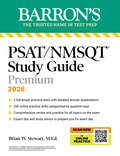
PSAT/NMSQT Premium Study Guide, 2026: 2 Practice Tests + Comprehensive Review+ 200 Online Drills (Barron's Test Prep)
By Brian W. Stewart M.Ed., Barron'S Educational Series. 2025
Barron&’s PSAT/NMSQT Study Guide Premium, 2026 includes everything you need to be prepared for exam day with comprehensive review and…
practice that reflects the digital PSAT/NMSQT! Internationally known expert author and tutor, Brian W. Stewart, a Princeton graduate and perfect SAT score holder, puts his 30,000 plus hours of teaching and tutoring experience to work for you. He gives you the same clear and concise advice to excel on the PSAT and SAT that has helped his students from all ability levels earn perfect scores and admission to Ivy League universities.All the Review You Need from an SAT Expert An expert overview of the digital PSAT/NMSQT, including answers to frequently asked questions, advice on curbing test anxiety, techniques for the digital interface, and information about the National Merit Scholarship program In-depth subject review and practice questions covering the each section of the test for Reading and Writing and Math The latest strategies for success for all question types on the digital PSAT, such as Command of Evidence, Words in Context, Rhetorical Synthesis, Transitions, Algebra, and Geometry and Trigonometry Tips throughout from the author--an experienced SAT tutor and test prep professional Practice with Confidence 2 full-length digital PSAT practice tests in the book- 1 diagnostic test to assess your skills and target your studying plus 1 fully adaptive Additional practice questions on each subject throughout the review chapters Advanced skill-building practice drills for students seeking National Merit Scholarship recognition Detailed answer explanations for all practice questions Online Practice 200 Online practice drills Detailed answer explanations Scoring to check your learning progress An online vocabulary appendix for extra review Publisher's Note: Products purchased from 3rd party sellers are not guaranteed by the publisher for quality, authenticity, or access to any online entities included with the product.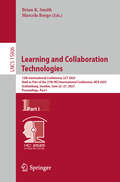
The three-volume set LNCS 15806–15808 constitutes the thoroughly refereed proceedings of the 12th International Conference on Learning and Collaboration Technologies,…
LCT 2025, held as part of the 27th International Conference, HCI International 2025, which took place in Gothenburg, Sweden, June 22-17, 2025. The total of 1430 papers and 355 posters included in the HCII 2025 proceedings was carefully reviewed and selected from 7972 submissions. The papers have been organized in topical sections as follows: Part I: Designing Learning Experiences; Technological Innovation in EducationPart II: From Human Teachers to AI Educators; Intelligent Learning Environments Part III: Serious Games and Gamification; Immersive Learning; Understanding Learning Experiences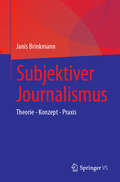
Subjektiver Journalismus: Theorie - Konzept - Praxis
By Janis Brinkmann. 2025
Journalismus wandelt sich – und bringt zunehmend neue Formen und Formate hervor, die u.a. investigative, narrative, interpretative oder partizipative Muster,…
Mechanismen und Merkmale des Journalismus integrieren und neu arrangieren. Doch wie sich ein teils explizit subjektiver und meinungsbasierter „Neuer Journalismus“ entwickelt und in der Praxis an Einfluss gewinnt, ist angesichts der oft fluiden Forschungsgegenstände in der Journalistik bislang nicht erforscht. Die vorliegende Studie, die am Institut für Journalistik an der Fakultät Kulturwissenschaften der Technischen Universität Dortmund als Habilitationsschrift eingereicht wurde, widmet sich daher Programmen, Praktiken und Leistungspotenzialen eines subjektiven Journalismus, wie er sich gegenwärtig in Formen des Social Journalism vollzieht (z.B. bei funk, Vice, BuzzFeed), der über soziale Medien jüngere Zielgruppen adressiert und sich radikal an deren Thematisierungs-, Präsentations-, Nutzungs- und Rezeptionserwartungen orientiert.Vor einer konstruktivistisch geprägten Hintergrundfolie wird zunächst ein integrativ-intergrativer Theorierahmen aufgespannt, der strukturell-individualistische mit figurations-analytischen und praxistheoretischen Bausteinen verknüpft, um die Konstruktionsprogramme, Praxiskonstellationen und Leistungspotenziale von Formen des subjektiven Journalismus zu rekonstruieren, zu analysieren und zu bewerten. Dafür wird ein triangulatives Methodendesign gewählt: Anhand kontemporärer Angebote eines subjektiven Journalismus, der sich besonders augenfällig in den Presenter-Reportagen des öffentlich-rechtlichen Content-Netzwerks funk manifestiert, werden Programme, Praktiken und Potenziale des subjektiven Journalismus durch quantitative und qualitative Inhaltsanalysen sowie eine flankierende Expert:innen-Befragung beteiligter Journalist:innen untersucht, um daraus Muster, Mechanismen und Merkmale eines „Neuen Journalismus“ zu destillieren. Als zentrales Ergebnis der Studie gewinnt eine nach den Mechanismen sozialer Medien für junge Zielgruppen aktualisierte und modifizierte Form des radikal subjektiven New Journalism an Kontur: Journalistische Wirklichkeit konstruieren Reporter:innen über eine an Zielgruppen- und Lebenswelt-Themen junger Publika orientierte Thematisierung, hybride Web-Reportagen, die konsequent eigene Meinung bzw. Haltung sowie subjektive Perspektiven integrieren sowie eine starke Fokussierung auf sich selbst und auf Protagonist:innen als Quellen und Akteure. Die Unterschiede zwischen verschiedenen empirisch rekonstruierbaren subjektiven Journalismen wie die eher reporter- bzw. recherche-getriebenen Slow Journalism und Gonzo-Journalismus oder die stärker protagonisten- bzw. emotions-getriebenen empathischer Journalismus und Selfie-Journalismus lassen sich am Beispiel der ausgewählten funk-Formate Y-Kollektiv, STRG_F, reporter, follow me.reports und Die Frage prägnant herausarbeiten. Für subjektiv modifizierte Praktiken wie thesengeleitete Recherche, interpretatives Storytelling, On-Presenting oder ein reflexives Framing greifen die Reporter:innen auf Modalitäten von Signifikationsregeln und autoritative Ressourcen wie persönliche Erfahrungen und Erlebnisse, eigene Meinungen und Haltungen sowie subjektive Darstellungs- und Erzählmuster zurück, die zu einem nunmehr artifiziell inszenierten und nicht länger authentisch konstruierten „strategischen Ritual“ der Subjektivität degenerieren, wenn Praxiskonstellationen wie die storybasierte Enthüllung, teilnehmende Beobachtung, emotionale Befragung oder selbstzentrierte Begleitung repetitiv Subjektivität in alle journalistischen Praktiken weben.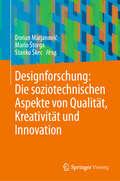
Designforschung: Die soziotechnischen Aspekte von Qualität, Kreativität und Innovation
By Mario Štorga, Dorian Marjanović, Stanko Škec. 2025
Das Buch bietet einen ganzheitlichen Einblick in die Designforschung, eine umfassende und zusammenhängende Vision des neuesten Wissens über die Schaffung…
und Verbesserung hochwertiger Produkte, Kreativität und Innovation. Die Beiträge in diesem Band dienen als erhellender Kompass für das Verständnis der Ingenieurdesignforschung und bieten eine umfassende Perspektive auf Produktentwicklung, Kreativität, Innovation, Erfindung und Produktivität, indem sie die historische Entwicklung der Designwissenschaft aufzeigen und die Grenzen der Ingenieurdesignforschung erkunden. Die vorgestellten Bildungsprojekte wurden an EU-Universitäten durchgeführt und bieten Einblicke für zukünftige Designkurse. Zentral in den Diskussionen ist die entscheidende Rolle der soziotechnischen Dimensionen im Ingenieurdesign, wobei Fragen der Kreativität, Qualität, menschzentrierter Methoden und der Anforderungen neuer Technologien erörtert werden, die ihre entscheidende Rolle für den Erfolg des Ingenieurdesigns betonen. Der Text bietet einen panoramischen Überblick über den aktuellen Stand der Designforschung und kritische Themen und liefert eine umfassende Übersicht für junge Forscher. Pädagogen und Mentoren werden ihr Wissen vertiefen, während Experten ihre Methoden und Werkzeuge verfeinern.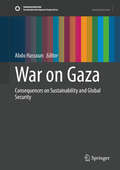
The relentless bombardment and blockade on Gaza have not only drastically restricted the inflow of essential food supplies but have…
also led to a catastrophic humanitarian crisis with unprecedented casualties. The widespread destruction has crippled the ability of the population to grow and process food, leaving Gazans without sufficient access to basic nutrition and pushing them to the brink of famine. Building on the previous work of Dr. Hassoun on acute food insecurity and malnutrition in Gaza, this book addresses not only Sustainable Development Goal (SDG) 2—Zero Hunger, SDG 3—Good Health and Well-being, and SDG 6—Clean Water and Sanitation, but all seventeen SDGs. While brief reports have been published on the topic, this will be the first in-depth scholarly work, offering case studies, data-driven analysis from various fields, and a comprehensive examination of the multidimensional and devastating impacts of war. With an urgent and multidisciplinary perspective, this book highlights the interconnectedness of war, sustainability, and global security, emphasizing how hostilities in Gaza have reversed progress toward achieving all SDGs, both in Gaza and beyond. Bringing together diverse expertise from 60 authors across 27 countries, the book showcases the international and interdisciplinary collaboration underlying its research. Through a series of carefully curated chapters written by specialists in various fields, it provides a comprehensive analysis of how war has affected societal structure, economic resilience, and environmental sustainability in Gaza. For each issue addressed, the text offers strategic insights and practical measures aimed at mitigating damage and fostering resilience. This book serves as a critical resource for policymakers, researchers, humanitarian organizations, and anyone who is interested in understanding and addressing the complex dynamics of conflict and sustainability.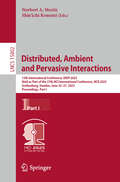
This two-volume set LNCS 15802-15803 constitutes the refereed proceedings of the 13th International Conference on Distributed, Ambient and Pervasive Interactions,…
DAPI 2025, held as part of the 27th International Conference on Human-Computer Interaction, HCII 2025, in Gothenburg, Sweden, during June 22-27, 2025. The total of 1430 papers and 355 posters included in the HCII 2025 proceedings was carefully reviewed and selected from 7972 submissions.The two volumes cover the following topics:Part I: Designing and developing intelligent environments; and user experience in intelligent environments.Part II: Smart cities and public spaces; eXtended reality and robots in intelligent environments; and wellbeing in intelligent environments.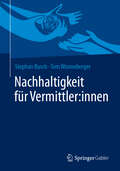
Nachhaltigkeit für Vermittler:innen
By Stephan Busch, Tom Wonneberger. 2025
Dieses Buch zeigt, was Nachhaltigkeit bei Finanzen und Versicherungen bedeutet: Informieren und sensibilisieren wir unsere Kund:innen. Finden wir neue Themen…
der Ansprache. Machen wir Druck auf unsere Produktpartner, ihre Angebote umzustellen. Nehmen wir das Heft des Handelns in die Hand und gestalten unsere kleinen wir großen Unternehmen um und machen sie zukunftsfest. Werden wir unserer sozialpolitischen Verantwortung gerecht. Tragen wir unseren Teil dazu bei, die Welt ein kleines Stück besser zu machen. Das Buch besteht aus drei Teilen. Im ersten beschäftigen wir uns mit den theoretischen Grundlagen. Wir erläutern, was Nachhaltigkeit ist und was es bedeutet. Wir begründen, warum es in jedem Fall wichtig und richtig ist, sich damit zu beschäftigen. Im zweiten Teil widmen wir uns den Strategien. Wir zeigen, wie die Transformation gelingt. Ein besonderes Augenmerk legen wir auf den Aspekt der nachhaltigen Beratung. Im dritten Teil geht es um die praktische Umsetzung. Hier zeigen wir konkrete Ansätze und Instrumente eingebettet in einen logischen Fahrplan, den Sie Stück für Stück abarbeiten können. Ganz am Ende finden Sie eine Checkliste und Arbeitsblätter.